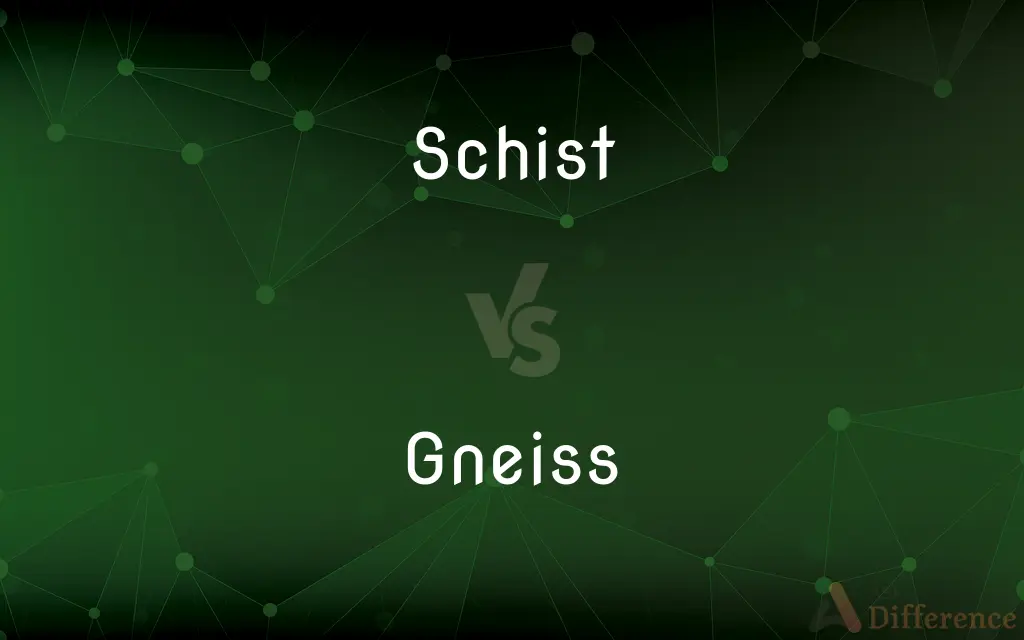Schist vs. Gneiss — What's the Difference?
By Tayyaba Rehman — Updated on October 26, 2023
Schist is a metamorphic rock characterized by a foliated appearance and micaceous minerals; Gneiss is a coarser-grained, banded metamorphic rock.

Difference Between Schist and Gneiss
Table of Contents
ADVERTISEMENT
Key Differences
Schist and Gneiss are both metamorphic rocks, formed under high temperature and pressure conditions. While Schist is known for its pronounced foliation due to the alignment of micaceous minerals, Gneiss is recognized by its bands or stripes, often alternating light and dark.
Schist's defining characteristic is its platy or sheet-like structure, resulting from the parallel arrangement of mineral grains. In contrast, Gneiss showcases a more varied mineral composition, which leads to its distinctive banded appearance.
Both Schist and Gneiss originate from pre-existing rocks through metamorphism. However, Schist often evolves from shale, mudstone, or basalt, whereas Gneiss typically develops from granite or diorite.
The name "Schist" is derived from the Greek word "schízein," meaning to split, referring to the rock's ability to be split into thin plates. On the other hand, "Gneiss" comes from the German word "gneist," which means spark, possibly alluding to its sparkling mineral constituents.
In terms of applications, Schist can be used for decorative stones and roofing materials due to its splitting ability. Gneiss, with its harder and more resistant nature, is often employed in construction, especially for building facades and countertops.
ADVERTISEMENT
Comparison Chart
Origin
From shale, mudstone, or basalt.
From granite or diorite.
Texture
Foliated, platy.
Banded, alternating light and dark.
Grain Size
Fine to medium.
Medium to coarse.
Name Origin
Greek word "schízein" (to split).
German word "gneist" (spark).
Common Uses
Decorative stones, roofing.
Building facades, countertops.
Compare with Definitions
Schist
Characterized by the alignment of micaceous minerals.
The shining surface of the Schist caught my attention.
Gneiss
A banded metamorphic rock.
The countertop was made of beautifully patterned Gneiss.
Schist
A metamorphic rock with a foliated texture.
The house was built using beautiful plates of Schist.
Gneiss
Has a more varied mineral composition than Schist.
The mineral diversity in the Gneiss gave it a unique appearance.
Schist
Often derived from shale or mudstone.
Under high pressures, the mudstone transformed into Schist.
Gneiss
Typically originates from granite or diorite.
The granite, over time and pressure, turned into Gneiss.
Schist
Recognizable by its platy or sheet-like structure.
The Schist rock was easily split into thin plates.
Gneiss
Known for its alternating light and dark bands.
The Gneiss rock displayed a rhythmic pattern of colors.
Schist
Used in construction for decorative purposes.
We decided to use Schist for our home's interior decor.
Gneiss
Commonly used in building facades and countertops.
The city's new monument showcased elegant Gneiss exteriors.
Schist
Schist ( shist) is a medium-grained metamorphic rock showing pronounced schistosity. This means that the rock is composed of mineral grains easily seen with a low-power hand lens, oriented in such a way that the rock is easily split into thin flakes or plates.
Gneiss
Gneiss ( nyse) is a common and widely distributed type of metamorphic rock. Gneiss is formed by high-temperature and high-pressure metamorphic processes acting on formations composed of igneous or sedimentary rocks.
Schist
Any of various medium-grained to coarse-grained metamorphic rocks composed of laminated, often flaky parallel layers of chiefly micaceous minerals.
Gneiss
A banded or foliated metamorphic rock, usually of the same composition as granite.
Schist
Any of a variety of coarse-grained crystalline metamorphic rocks with a foliated structure that allows easy division into slabs or slates.
Gneiss
(geology) A common and widely-distributed metamorphic rock having bands or veins, but not schistose.
Schist
Any crystalline rock having a foliated structure (see Foliation) and hence admitting of ready division into slabs or slates. The common kinds are mica schist, and hornblendic schist, consisting chiefly of quartz with mica or hornblende and often feldspar.
Gneiss
A crystalline rock, consisting, like granite, of quartz, feldspar, and mica, but having these materials, especially the mica, arranged in planes, so that it breaks rather easily into coarse slabs or flags. Hornblende sometimes takes the place of the mica, and it is then called hornblendic gneiss or syenitic gneiss. Similar varieties of related rocks are also called gneiss.
Schist
Any metamorphic rock that can be split into thin layers
Gneiss
A laminated metamorphic rock similar to granite
Common Curiosities
From which rocks does Schist commonly originate?
Schist often evolves from shale, mudstone, or basalt.
Are both Schist and Gneiss found naturally?
Yes, both are naturally occurring metamorphic rocks.
What gives Gneiss its banded appearance?
Gneiss has a varied mineral composition that leads to its alternating light and dark bands.
Which rock is typically finer-grained, Schist or Gneiss?
Schist is typically finer-grained compared to Gneiss.
Can Schist be used for roofing?
Yes, due to its ability to split, Schist is often used for roofing.
Why is Gneiss commonly used in building facades?
Gneiss is hard, resistant, and has a visually appealing banded texture, making it suitable for facades.
How do the names 'Schist' and 'Gneiss' originate?
'Schist' comes from the Greek word "schízein" (to split), and 'Gneiss' from the German word "gneist" (spark).
What type of rock is Schist?
Schist is a foliated metamorphic rock.
Is Gneiss derived from Schist?
Not typically. Gneiss usually develops from granite or diorite.
Are there color variations in Gneiss?
Yes, Gneiss is known for its alternating light and dark bands resulting from its mineral composition.
Which is more susceptible to weathering, Schist or Gneiss?
Schist, being finer-grained and more foliated, tends to be more susceptible to weathering than Gneiss.
Can both Schist and Gneiss be used for countertops?
While Gneiss is more commonly used for countertops due to its hardness, Schist can also be used if appropriately treated.
What's the main visual difference between Schist and Gneiss?
Schist has a foliated, platy texture while Gneiss displays a banded appearance.
Is Gneiss harder than Schist?
Generally, Gneiss is harder and more resistant than Schist.
Can Schist be used in interior decor?
Yes, Schist can be used for decorative purposes due to its aesthetic appeal.
Share Your Discovery

Previous Comparison
Demise vs. Devise
Next Comparison
Bibliography vs. BiographyAuthor Spotlight
Written by
Tayyaba RehmanTayyaba Rehman is a distinguished writer, currently serving as a primary contributor to askdifference.com. As a researcher in semantics and etymology, Tayyaba's passion for the complexity of languages and their distinctions has found a perfect home on the platform. Tayyaba delves into the intricacies of language, distinguishing between commonly confused words and phrases, thereby providing clarity for readers worldwide.
















































